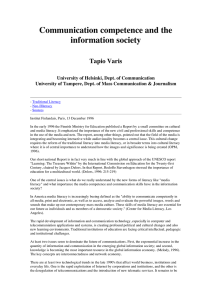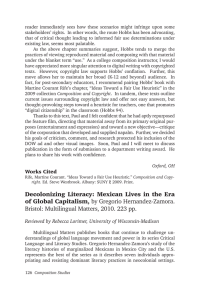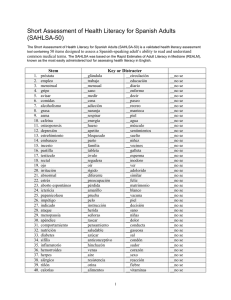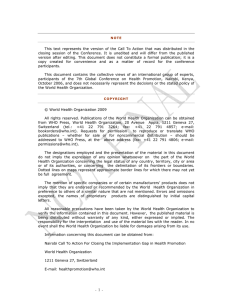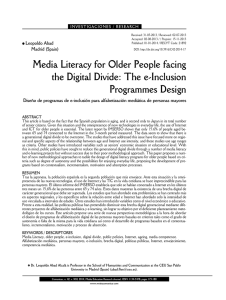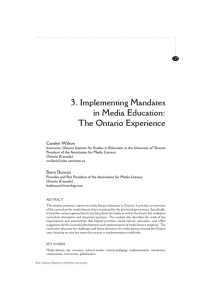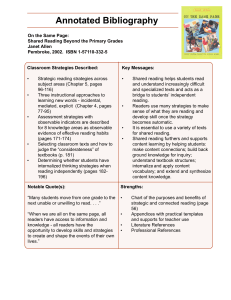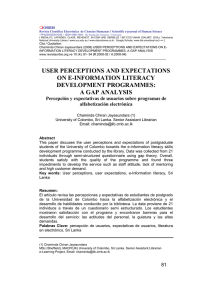Health literacy
Anuncio
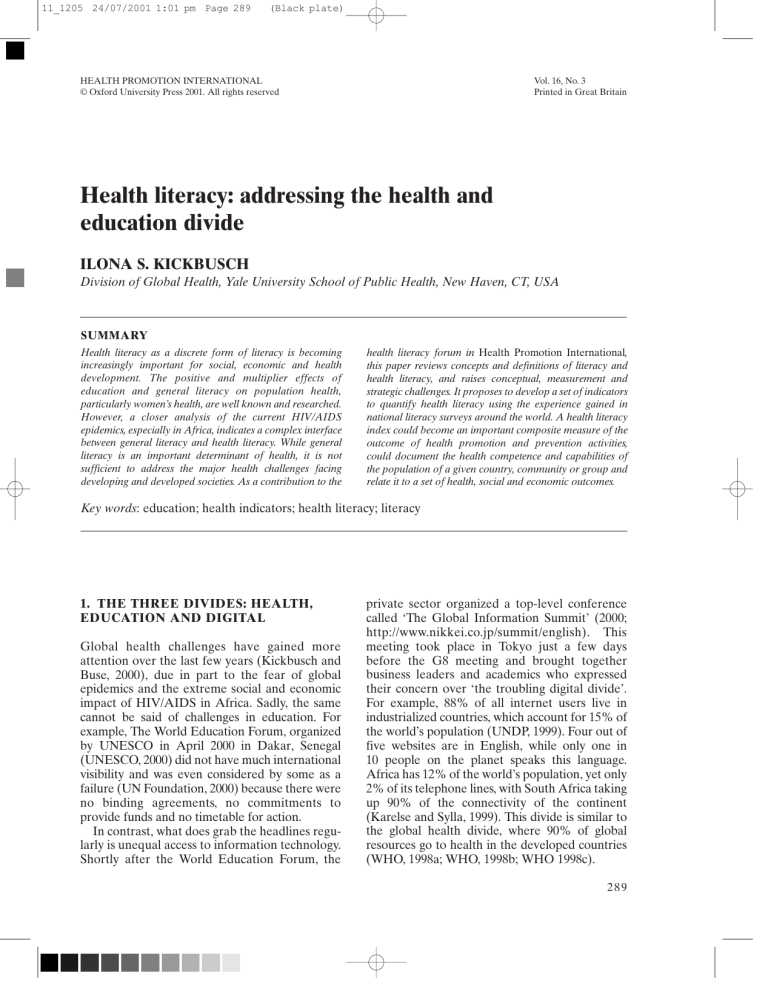
11_1205 24/07/2001 1:01 pm Page 289 (Black plate) HEALTH PROMOTION INTERNATIONAL © Oxford University Press 2001. All rights reserved Vol. 16, No. 3 Printed in Great Britain Health literacy: addressing the health and education divide ILONA S. KICKBUSCH Division of Global Health, Yale University School of Public Health, New Haven, CT, USA SUMMARY Health literacy as a discrete form of literacy is becoming increasingly important for social, economic and health development. The positive and multiplier effects of education and general literacy on population health, particularly women’s health, are well known and researched. However, a closer analysis of the current HIV/AIDS epidemics, especially in Africa, indicates a complex interface between general literacy and health literacy. While general literacy is an important determinant of health, it is not sufficient to address the major health challenges facing developing and developed societies. As a contribution to the health literacy forum in Health Promotion International, this paper reviews concepts and definitions of literacy and health literacy, and raises conceptual, measurement and strategic challenges. It proposes to develop a set of indicators to quantify health literacy using the experience gained in national literacy surveys around the world. A health literacy index could become an important composite measure of the outcome of health promotion and prevention activities, could document the health competence and capabilities of the population of a given country, community or group and relate it to a set of health, social and economic outcomes. Key words: education; health indicators; health literacy; literacy 1. THE THREE DIVIDES: HEALTH, EDUCATION AND DIGITAL Global health challenges have gained more attention over the last few years (Kickbusch and Buse, 2000), due in part to the fear of global epidemics and the extreme social and economic impact of HIV/AIDS in Africa. Sadly, the same cannot be said of challenges in education. For example, The World Education Forum, organized by UNESCO in April 2000 in Dakar, Senegal (UNESCO, 2000) did not have much international visibility and was even considered by some as a failure (UN Foundation, 2000) because there were no binding agreements, no commitments to provide funds and no timetable for action. In contrast, what does grab the headlines regularly is unequal access to information technology. Shortly after the World Education Forum, the private sector organized a top-level conference called ‘The Global Information Summit’ (2000; http://www.nikkei.co.jp/summit/english). This meeting took place in Tokyo just a few days before the G8 meeting and brought together business leaders and academics who expressed their concern over ‘the troubling digital divide’. For example, 88% of all internet users live in industrialized countries, which account for 15% of the world’s population (UNDP, 1999). Four out of five websites are in English, while only one in 10 people on the planet speaks this language. Africa has 12% of the world’s population, yet only 2% of its telephone lines, with South Africa taking up 90% of the connectivity of the continent (Karelse and Sylla, 1999). This divide is similar to the global health divide, where 90% of global resources go to health in the developed countries (WHO, 1998a; WHO, 1998b; WHO 1998c). 289 11_1205 24/07/2001 1:01 pm Page 290 290 (Black plate) I. S. Kickbusch What is nearly always neglected in this hardware-driven debate, which hopes to bring information technology to the most remote parts of the world, is that nearly one billion of the world’s poorest people ‘have not yet experienced the Education Age’ (Netaid.org, 2000). The data (UNESCO, 1997a; UNESCO, 1997b) in relation to the education divide are as daunting as those regarding the digital divide, and perhaps more so. There are an estimated 876 million illiterate adults in the world (~25% of the world’s adult population), and the majority of them are women and girls. The World Education Summit 2000 estimated that US$8 billion would be needed annually to achieve education for all by the year 2015. More than 130 million children are not enrolled in school, and of those who are, many do not get an education that will prepare them for life in rapidly changing societies. The India Literacy Project (ILP, 2000) cites data indicating that India’s literacy levels still hover around 60%, due in particular to a very low rate of female literacy. But even in the developed world, ~100 million people are functionally illiterate (OECD, 1997). These high levels of illiteracy contribute significantly to the disease burden of poor communities and countries, and reinforce health and economic inequalities. An OECD study from the late 1990s raised the distressing fact that ‘one quarter of adults fails to meet the minimum level of literacy needed to cope with the demands of life and work in OECD countries’ [Literacy, Economy and Society (OECD, 1997)]. While the study has been criticized for what Graff considers a too narrow concept of literacy (Graff, 1996), it does appropriately highlight that a significant part of the population, even in the richest countries, is ill-equipped to deal with a rapidly changing society. In describing Global Trends 2005, Michael Mazaar describes the strategic importance of learning for the fate of humankind (Mazaar, 1999). Any society that wants to stay competitive in the 21st century will need to prepare itself for this new emphasis on knowledge, learning and education. Rosencrance echoes this sentiment by stating that one of the new roles of the ‘virtual state’ is to ensure peaceful competitiveness through investments in education (Rosencrance, 1999): At the ultimate stage, competition among nations will be competition among educational systems, for the most productive and richest countries will be those with the best education and training. (p. xv) Keating and Hertzman link both the potentials for future economic growth and for the sustenance of civil society in the information age to the quality of human resources available (Keating, 1999), as does Street in his survey of Economics and Literacy for Canada specifically (Street, 1999). They emphasize that steep social and economic gradients in health, coping and competence will impair the creation of a learning society that values not only increased material abundance, but also improved health and quality of life. Considering the developing world, Amartya Sen (1999) has argued forcefully for a ‘support led’ development approach that ensures high investments in education, health and social infrastructure. He illustrates how the expansion of social opportunities and individual capabilities can, in turn, lead to significant and sustainable increases in economic growth and social well-being. 2. HEALTH, EDUCATION AND HEALTH LITERACY Health researchers and health care professionals, from both the developed and developing worlds, have long been concerned about the link between health and education (Evans et al., 1994; Health Canada, 1999; World Bank, 2000). Education and literacy rank as key determinants of health, along with income and income distribution, employment, working conditions and the social environment, although the interrelationships and weighting of these various determinants demand further research. The second Canadian health report ‘Towards a Healthy Future’ states: … literacy levels, which are usually, but not always, related to levels of education, are important predictors of employment, active participation in the community and health status. They are also important predictors of the success of a nation (Health Canada, 1999). The report mentions in various chapters how Canada’s high ranking in the UNDP Human Development Index (UNDP, 1998) drops when parameters such as income distribution and literacy are factored in. Reports abound from developing countries that highlight the positive impact of education and literacy on population, health and, in particular, womens’ health and the health of children 11_1205 24/07/2001 1:01 pm Page 291 (Black plate) Addressing the health literacy divide (Caldwell, 1986; Bledsoe et al., 1999; Sen, 1999; Nussbaum, 2000). The recent report on the State of the World’s Mothers by Save the Children (Save the Children, 2000) has identified the adult female literacy rate (the percentage of women over the age of 15 years who can read and write), as one of the 10 key indicators to assess ‘women’s well-being’. It is estimated that two-thirds of the world’s 960 million illiterate adults are women. All countries ranked in the top 10 for ‘women’s well-being’ have a female literacy rate of 90% and higher. Latin America has an 80% female literacy rate—the highest among developing nations. In contrast, Africa has the lowest rate with wide disparities. For example, South Africa and Zimbabwe have a literacy rate close to 80%, while in some of the poorest countries, such as Niger and Burkina Faso, only 10% of women can read and write. A mother’s level of education correlates closely with a child’s risk of dying before age 2 years. Developing countries that have achieved a female literacy rate ranging from 70 to 83% have also achieved an infant mortality rate of 50 (per 100 000) or lower (Save the Children, 2000). Income for women rises by 10–20% for each additional year of schooling. Educated women are more likely to postpone marriage and childbirth, give better health care to their families, and send their children to school and contribute to overall economic growth (Filmer, 1999). The strong relationship between women’s educational level and the total fertility rate of the society is well documented. The insufficiently considered impact of improved educational levels among women of childbearing age is beginning to disprove the dire predictions of an impending population explosion. Much of the research on health and education has focused on population health effects. Recently, however, re-analysis of epidemics such as that of HIV/AIDS has brought new issues and relationships to the fore (Crawley, 2000; UNICEF, 2000). While Zimbabwe and South Africa have some of the highest literacy rates in Africa, they are also the countries most severely challenged by HIV/AIDS. It is estimated that in Zimbabwe, up to 25% of the population is infected, the majority of them women (UNAIDS/WHO, 1999). UNICEF’s recent Progress of Nations Report 2000 highlights that there is a disproportionately high incidence of HIV/AIDS among sub-Saharan African teachers (UNICEF, 2000). In 1999, at least 860 000 elementary students in sub-Saharan Africa lost a 291 teacher to HIV/AIDS. The rate was particularly high in Kenya, where ~1400 teachers died in 1999, affecting some 95 000 primary students (compared to only 10 teachers in 1993). Consider the 1999 data for other African countries: in South Africa 100 000 students lost a teacher to HIV/AIDS, in Zimbabwe it was 86 000, and in Nigeria 85 000. The high death rate of teachers shows clearly that general literacy and health literacy do not necessarily go hand in hand. It illustrates that literacy and health literacy are moving targets and must be viewed in context. For example, the high death rate in teachers can partly be explained by the fact that many teachers are women and in most of these cultures, women do not have much power in relation to their family roles and their husbands’ sexual demands. It demonstrates drastically the impact of low health literacy on other policy sectors, in this case education. Hard-won gains in school, health and general literacy in the African countries are being seriously endangered, with increasing effects on social and economic development. These effects open up an avenue for a common agenda between health and education, focusing on the interrelationship and the interdependence between investing in both literacy and health literacy, in schools and in society overall (Harrison, 1997). While education and literacy are important determinants of health, health literacy as a discrete form of literacy is becoming increasingly important for social and economic development. The challenges we face are to: • develop reliable measures of the health literacy of societies and population groups; • quantify scientifically its impact on health and quality of life outcomes; and • propose public health interventions that significantly increase health literacy along its various dimensions. The next step is to revisit some definitions and measurements of general literacy, and discuss to what extent they can be applied to the specific challenges of health literacy. 3. SOME DEFINITIONS OF LITERACY The literacy debate has long moved away from a simplistic understanding of literacy as the capacity to read, write and have basic numeric skills (‘the three Rs’) to one that accounts for 11_1205 24/07/2001 1:01 pm Page 292 292 (Black plate) I. S. Kickbusch complexity, culture, individual empowerment and community development. Consequently, the more recent thinking on literacy shows a close affinity to the approaches developed in the health promotion field around the Ottawa Charter (WHO/HWC/CPHA, 1996). A working definition of literacy for the 21st century that attempts to integrate a broad range of factors has been proposed by the Center for Literacy of Quebec (CLQ, 2000): Literacy involves a complex set of abilities to understand and use the dominant symbol system of a culture for personal and community development. The need and demand for these abilities vary in different societies. In a technological society, the concept is expanding to include the media and electronic text in addition to alphabets and numbers. Individuals must be given life-long learning opportunities to move along a continuum that includes reading, writing, critical understanding and the decision-making abilities they need in their communities. Increasingly, literacy is viewed as including a variety of skills needed for an adult to function in society. The Canadian Education Research Information System has identified six such skills (CERIS, 1999): • • • • • • quantitative literacy; scientific literacy; technological literacy; cultural literacy; media literacy; and computer literacy. It is essential to add health literacy to this list and include it in the policy agenda. The reason for this is not far-fetched; health and disease exist in a cultural matrix and health promotion interventions must respond to the local context (Jahan, 2000). The connection between literacy, health, wealth and well-being will gain increasing importance not only in the face of extreme epidemics such as those described above, but also because societies will be increasingly dependent on healthy populations to manage health care costs in the face of ageing populations (Ziegler, 1998). Following this line of thinking, it is necessary to develop a set of measurements that indicates the full range of societal benefits to be derived from a health-literate population. This could provide new and productive dimensions to the debate on the effectiveness and evidence base of health promotion and health education. 4. SOME DEFINITIONS OF HEALTH LITERACY In order to create alliances between the general literacy debate and the health literacy effort, it will be necessary to have a more systematic dialogue between the two fields of study and practice. The debate on health literacy has emerged from two very different sources: (i) the community development approaches around a Freirean model of adult learning (Freire, 1985; Freire and Macedo, 1987), particularly as linked to empowerment and applied in a Latin American context (Wallerstein and Bernstein, 1994); and (ii) an approach that arose out of a concern over the poor health literacy levels of large numbers of patients in the American health care system (Parker et al., 1995; Pfizer 1998; Parker, 2000). The Center for Health Care Strategies Inc. (Center for Health Care Strategies Inc., 2000) proposes a highly functional approach. They offer the following simple definition of health literacy: Health Literacy is the ability to read, understand, and act on health care information. This short and succinct approach follows the definition of literacy as used in the 1992 National Adult Literacy Survey in the USA, which defined literacy as ‘using printed and written information to function in society’ (Kirsch et al., 1993). The authors go on to define ‘functional health literacy’ as ‘the ability to apply reading and numeracy skills in a health care setting’. These skills include the ability to: • read consent forms, medicine labels and inserts, and other written health care information; • understand written and oral information given by physicians, nurses, pharmacists and insurers; and • act upon necessary procedures and directions such as medication and appointment schedules. The Ad Hoc Committee on Health Literacy for the Council on Scientific Affairs of the American Medical Association chose a slightly wider, skills-based view on health literacy and defines it as: … a constellation of skills, including the ability to perform basic reading and numerical skills required to function in the health care environment (Ad Hoc Committee on Health Literacy, 1999). 11_1205 24/07/2001 1:01 pm Page 293 (Black plate) Addressing the health literacy divide 293 health literacy not only as a personal characteristic, but also as a key determinant of population health. The report stresses that most health professionals are not aware of their patients’ low health literacy levels or that most patients are too embarrassed to indicate to their health care providers that they have not really understood their instructions. While the report touches on wider issues, such as the links between literacy and various health indicators, including healthpromoting behaviors, it does remain focused on medical and health care settings. In contrast, the US Healthy People 2010 objectives (USDHHS, 2000) link health literacy to the promotion of health and preventive behaviors, and even moves it beyond just functional literacy. It defines health literacy as: 5. MEASURING HEALTH LITERACY AT A POPULATION LEVEL: SOME SUGGESTIONS The capacity to obtain, interpret and understand basic health information and services and the competence to use such information and services to enhance health. • prose literacy (understanding texts); • document literacy (being able to understand and fill out forms, formats, maps, tables); and • quantitative literacy (the ability to apply arithmetic operations). Healthy People 2010, for the first time, sets developmental targets for health literacy in the US [developmental because of unresolved baseline data and measurement issues, and a dependency on the general literacy surveys instead of a separate health literacy rating instrument (Ratzan, 2001)]. The document states that low literacy contributes to the denial of full health benefits to a very large segment of the US population. Fundamental fairness and equity are cited as quintessential in closing the gap in health. Despite this orientation, Healthy People 2010 does not include the forward-looking notion of ‘potential’ into the health literacy definition. However, the broadest definition of health literacy as proposed in the WHO health promotion glossary does include this concept (Nutbeam, 1998): Health literacy represents the cognitive and social skills which determine the motivation and ability of individuals to gain access to, understand and use information in ways which promote and maintain good health. This definition was recently discussed at a Health Literacy Workshop at the 5th WHO Global Conference on Health Promotion (PAHO/Yale/ Pfizer workshop on Health Literacy, Mexico, June 2000). The workshop resolved to widen the glossary definition to include the dimensions of community development and health-related skills beyond health promotion, and to understand Some guidance for measuring health literacy at the population level can be found in the classifications adopted for measuring general literacy. For example, the second report of the IALS uses three ‘literacy domains’: Along these lines, a first step towards measurement could be agreement on the key domains for health literacy by using, for example, the three areas that have been proposed by Nutbeam (2001): • functional health literacy; • interactive health literacy; and • critical health literacy. A set of indicators or scales should be developed for each domain in order to circumscribe broad health literacy levels. One could then compare differences in health literacy between gender, population and age groups, and relate it to levels of education and income. Important issues will be: (i) to separate clearly education, general literacy and health literacy; (ii) to look particularly closely at how these three factors interrelate; and (iii) to distinguish what reinforcing mechanisms might be at work. Finding measures that reflect health literacy in terms of knowledge and in terms of the capabilities to act, solve problems and evaluate circumstances will be a challenge. In short, measuring health literacy could be the first major step in constructing a new type of health index for societies that complements measures such as the disability adjusted life years (DALYs), and morbidity and mortality data. It would go beyond considering the GNP expenditure per capita on medical care as a society’s contribution to health. It could also respond to some of the challenges posed by Drummond and 11_1205 24/07/2001 1:01 pm Page 294 294 (Black plate) I. S. Kickbusch Stoddart with regard to intersectoral economic evaluation (Drummond and Stoddart, 1995). A health literacy index, supported by the advances made in analyzing multi level data, could aim to document the composite health competence and capabilities of the population of a given country, community or group and relate it to a set of health, social and economic outcomes. 6. HEALTH LITERACY IS ABOUT EMPOWERMENT Just as a broader, more modern concept of health includes physical, mental and social well-being, a broader understanding of literacy includes a range of skills to navigate and apply knowledge. Both health and literacy are dynamic concepts that influence, and to some extent determine, our ability to function in a rapidly changing society. ‘Health’ is a societal system that has become increasingly complex in all its components, and requires a wide range of knowledge and skills to respond adequately in times of illness. Health literacy involves understanding and ability to judge, sift and use information provided in the context of one’s own life—this is the key element of critical health literacy as put forward by Don Nutbeam (Nutbeam, 2001). It is important to clarify the issue of power in the health literacy debate, in order that the promotion of health literacy does not focus just on compliance issues. It has been suggested that a lack of concern with empowerment has been one of the reasons why large-scale literacy efforts around the world have failed. The same is true for many efforts in health education, particularly as they concern women, sexuality and reproduction. Information is crucial, but will never be sufficient to address many of the major challenges faced by disenfranchised and marginalized populations. Components of health literacy, such as access to information and knowledge, informed consent, and negotiating skills must constitute part of the overall development effort. Far from being able to weigh the risks of various alternatives, people frequently have no choices. How can they assess relative risk if only one type of treatment is available to them? As options and complexities grow in developed countries, the health gap becomes ever more obvious on a global scale. Why should some be able to live longer because they have had the good fortune to be born in a country that provides its citizens with access to HIV/AIDS information and antiretroviral drugs? An important conceptual model for health literacy as empowerment can be found in Martha Nussbaum’s ‘capabilities approach’. She argues that capability, rather than functioning, is the appropriate political goal because it emphasizes ‘what people are able to do or be’; it firmly places the capacity of citizens to act within their social environment. She says: When we think of health, for example, we should distinguish between the capability or opportunity to be healthy and actual healthy functioning: a society might make the first available and also give individuals the freedom not to choose the relevant functioning [(Nussbaum, 2000), p. 14]. 7. HEALTH LITERACY IS A KEY PUBLIC HEALTH ISSUE While public policies need to set certain preconditions for health, people must also actively participate in their health as part of their contribution to civil society, hence the importance of developing all three domains of health literacy. Health promotion frames health as a resource for everyday life, and it describes health creation as a process of increasing people’s control over their health and its determinants. Health literacy research can explore further research avenues such as empowerment processes, survey designs for health literacy assessment of different population groups, and outcome measures of health promotion interventions. The health literacy working group at the Mexico conference recommended that a set of indicators be developed to measure the health literacy level of a community. It was suggested that this could include, in particular, ‘relational’ and dynamic aspects of health literacy (a slightly broader understanding of the second domain proposed by Nutbeam). How is health knowledge sought out and shared within a community? How easy it is to access the health resources of a community and of the society at large? What defines the dominant health culture of a community? This proposal is similar to what Keating describes as knowledge building within a learning community (Keating, 1999). He refers to research that indicates that learning frequently 11_1205 24/07/2001 1:01 pm Page 295 (Black plate) Addressing the health literacy divide occurs more effectively in collaborative networks than as an individual effort. Similarities emerge with another broad concept of the current health care debate; that of social capital. Both health literacy and social capital are measurable determinants of population health outcomes. Social capital (Coleman, 1988) refers to the features of social organization such as networks, norms and social trust that facilitate coordination and collaboration for mutual benefit. A study by Kawachi et al. shows that feelings of trust and security within the neighborhood in which one lives can make a significant difference to health status (Kawachi and Kennedy, 1997). The influence of social capital and health literacy is part of the development of a more integrative public health agenda that moves beyond a disease-by-disease and risk-by-risk approach. Indeed, there could be a significant overlap and reinforcing quality between these two factors. In terms of defining the core components of health literacy and its measurement, it would be helpful to review the social capital literature and to include those researchers in the health literacy dialogue. 8. OUTLOOK Eighty percent of the world’s population live in oral and visual cultures, i.e. cultures that learn through listening and watching, not through reading or writing (Goody, 1968). Some people predict that developed societies are moving in this direction as well, and that reading and writing has been, historically, an interim phenomenon (Crossman, 1999). The media, which is increasingly becoming a key source of health information to most people, is reshaping and influencing the cultures of both developed and developing countries. The new information technologies might provide learning opportunities that are more visual and interactive than pamphlets and older, more didactic forms of health instructions. They can be used individually, in groups and in the classroom. Learning about health by surfing the net, visiting chat rooms, and talking to others thousands of miles away with the same problem is already a reality for some. Maybe, in the future, when you get a pill bottle, you will not be handed an object with a little label that nobody can read let alone understand. Maybe you will get a short video with your pills, or a message sent to your 295 hand-held portable device that will explain what the medication is for and how to take it properly (with an inbuilt reminder). Knowledge is a global public good (Stieglitz, 1999). National and international calls to action are necessary, and we must combine efforts to close the digital divide with efforts to close the education and the health divide (World Bank, 1998). New technology—particularly if we are also willing to accept the Internet as a global public good—can help address literacy and health challenges in a new way by offering new forms of learning. As part of this move, we must make health literacy a key dimension of the literacy drive that is just beginning to gain new momentum. Singapore, for example, invested US$1.2 billion in 1997 to wire every school to the Internet. Singapore’s education minister drew attention to the key logic behind this investment: We need to ask: is the WHOLE society I.T. ready—if not it will be saddled with the inefficiency of running dual systems (Yeomans, 1999). In the health arena at present, both at the country and global levels, dual systems do exist: one for those with resources, and a safety net for those without. Short-term efficiency gains in health care reform are constantly highlighted, but investments in those areas that really create health rarely make the agenda. Health literacy as a major health investment and health development strategy needs long-term commitment, strong partnerships and powerful spokespeople. The new global alliances that concern themselves with eradicating disease and developing new vaccines need to be complemented by a strong commitment to increase overall health literacy in close cooperation with a public policy commitment at country level. Health literacy demands the awareness, just as the digital divide does, that if we do not close the health literacy gap, the whole of society, indeed the global community, will suffer. ACKNOWLEDGEMENTS The research assistance provided by Allison Stockman and Kenneth Muoghalu in the final preparation of this paper is acknowledged and appreciated. This work was supported, in part, by Pfizer Inc. 11_1205 24/07/2001 1:01 pm Page 296 296 (Black plate) I. S. Kickbusch Address for correspondence: Ilona Kickbusch Yale University School of Public Health 60 College Street New Haven CT 06520-8034 USA REFERENCES Ad Hoc Committee on Health Literacy (1999) Health literacy: report of the Council on Scientific Affairs, American Medical Association. Journal of the American Medical Association, 281, 552–557. Bledsoe, C. H., Casterline, J. B., Jonson-Kuhn, J. A. and Haaga, J. G. (eds) (1999) Critical Perspectives on Schooling and Fertility in the Developing World. National Academy Press, Washington DC, USA. Caldwell, J. C. (1986) Routes to low mortality in poor countries. Population and Development Review, 12, 171–220. Canadian Education Research Information System (CERIS) (1999) Literacy: Definitions. http://www.schoolnet. ca/ceris/e/Literacy1.html. CEA, Ontario, Canada. Center for Health Strategies Inc. (CHCS) (2000) Fact sheet. What is Health Literacy? CHCS, Princeton, NJ, USA. Centre for Literacy of Quebec (2000) A Working Definition: Literacy for the 21st Century. http://www.nald. ca/litcent.html. The Center for Literacy of Quebec, Montreal, Quebec, Canada. Coleman, J. S. (1988) Social Capital in the creation of human capital. American Journal of Sociology, 94s, S95–S120. Crawley, M. (2000) How AIDS undercuts education in Africa. Christian Science Monitor, July 25, 2000. http://www.csmonitor.com/durable/2000/)7/25/pls4.htm. The Christian Science Publishing Society, Boston, MA, USA. Crossman, W. (1999) The Coming of Age of Talking Computers. The Futurist, 33, 42–48. Drummond, M. and Stoddart, G. (1995) Assessment of health producing measures across different sectors. Health Policy, 33, 219–231. Evans, R., Barer, M. and Marmor, T. (eds) (1994) Why are some people healthy and others not? The determinants of Health of Populations. Aldine de Gruyter, NY, USA. Filmer, D. (1999) The Structure of Social Disparities in Education: Gender and Wealth. Policy Research Report on Gender and development Working Paper No. 5 (http://www.worldbank.org/gender/prr). World Bank, Washington DC, USA. Freire, P. (1985) The Politics of Education: Culture, Power and Liberation. Macmillan, Houndsmills, Basingstoke, NH, USA. Freire, P. and Macedo, D. (1987) Literacy: Reading the Word and the World. Bergin & Farvey Publishers, Farvey South Hadley, MA, USA. Goody, J. (ed.) (1968) Literacy in Traditional Societies. Cambridge University Press, Cambridge, UK. Graff, H. (1996) The Persisting Power and Costs of the Literacy Myth. Literacy across the Curriculum 12 (2) (http://www.nald.ca/province/que/litcent/Publications_ Products/working/page/3.html). Centre for Literacy, Montreal, Canada. Harrison, K. (1997) The importance of the educated, healthy woman in Africa. The Lancet, 349, 644–647. Health Canada (1999) Toward a Healthy Future: Second Report on the Health of Canadians. (http://www.hc-sc.gc. ca/hppb/phdd/report/text_versions/english/index.html.) Health Canada, Ottawa, Canada. India Literacy Project (ILP) (2000) (Http://www.ilpc.org/) ILP, Washington DC, USA. Jahan, A. J. (2000) Promoting health literacy: a case study in the prevention of diarrhoeal disease from Bangladesh. Health Promotion International, 15, 285–291. Karelse, C. and Sylla, F. S. (1999) Rethinking education for the production, use and management of ICTs. In Rathgeber, E. M. and Adera, E. O. (eds) Gender and the Information Revolution in Africa. (http://www. idrc.ca/books/focus/903/08-chp05.html). International Development Research Center, Ottawa, Canada. Kawachi, I. and Kennedy, B. (1997) Health and social cohesion: why care about income inequality? British Medical Journal, 314, 1037–1040. Keating, D. P. (1999) Developmental health as the Wealth of Nations. In Keating, D. P. and Hertzman, C. (eds) Developmental Health and the Wealth of Nations. The Guilford Press, New York, USA. Kickbusch, I. and Buse, K. (2000) Global influences and global responses: international health at the turn of the 21st century. In Merson, M. H., Black, R. E. and Mills, A. J. (eds) International Health. A Textbook. Aspen, New York, USA, pp. 701–732. Kirsch, I., Jungeblut, A., Jenkins, L. and Kolstad, A. (1993) Adult Literacy In America. A First Look at the Results of the National Adult Literacy Survey. National Center for Education Statistics, US Departmant of Education, Washington DC, USA. Mazaar, M. (1999) Global Trends 2005: an Owner’s Manual for the Next Decade, 1st edn. St Martins Press, New York, USA. Netaid.org (2000) An Education Divide in a Digital World. (http://app.netaid.org/WhatWorks/1.0.html?pillar_id=5). Netaid.org Foundation, New York, USA. Nussbaum, M. C. (2000) Women and Human Development. The Capabilities Approach. Press Syndicate of the University of Cambridge, Cambridge, UK. Nutbeam, D. (2001) Health literacy as a public health goal. Health Promotion International, in press. Organization for Economic Co-operation and Development (OECD) (1997) Second Report of the International Adult Literacy Survey: Literacy Skills for the Knowledge Society. OECD, Paris, France. Parker, R. (2000) Health Literacy: a challenge for American patients and their health care providers. Health Promotion International, 15, 277–283. Parker, R. M., Baker, D. W., Williams, M. Y. and Nurss, J. R. (1995) The test of functional health literacy in adults: a new instrument for measuring patients’ literacy skills. Journal of General Internal Medicine, 10, 537–541. Pfizer Inc. (1998) Promoting Health Literacy: a Call to Action. Conference Proceedings. Pfizer Inc., New York, USA. Ratzan, S. (2001) Health literacy: communication for the public good. Health Promotion International, 16, 207–214. 11_1205 24/07/2001 1:01 pm Page 297 (Black plate) Addressing the health literacy divide Rosencrance, R. (1999) The Rise of the Virtual State. Wealth and Power in the Coming Century. Basic Books, New York, USA. Save the Children (2000) State of the World’s Mothers. Save the Children, Westport, CT, USA. Sen, A. (1999) Development as Freedom. Oxford University Press, Oxford, UK. Stieglitz, J. E. (1999) Knowledge as a global public good. In Kaul, I., Grunberg, I. and Stern, M. A. (eds) Global Public Goods: International Cooperation In The 21st Century. Oxford University Press, Oxford, UK. Street, B. (1999) Literacy, Economy and Society: a Review. Accessed on CERIS. UNAIDS/WHO (1999) AIDS Epidemic Update: December 1999 (mimeograph). WHO, Geneva. UN Foundation (2000) May 1 edition: http://www. unfoundation.org. United Nations Childrens Fund (UNICEF) (2000) The Progress of Nations 2000. http://www.unicef.org/pon00/ data3.htm. UNICEF, New York, USA. United Nations Development Programme (UNDP) (1998) Human Development Report. Oxford University Press, New York, USA. United Nations Development Programme (UNDP) (1999) Human Development Report. Oxford University Press, New York, USA. United Nations Educational, Scientific and Cultural Organization (UNESCO) (1997a) Adult Education in a Polarizing World: Education for All, Status and Trends/1997. UNESCO, Paris, France. United Nations Educational, Scientific and Cultural Organization (UNESCO) (1997b) CONFINTEA V: Fifth International Conference on Adult Education, Hamburg, 14–18 July 1997, conference documents 297 (http://www.unesco.org/education/uie/confintea/index/ html). UNESCO, Paris, France. United Nations Educational, Scientific and Cultural Organization (UNESCO) (2000) World Education Forum in Dakar, Senegal, 26–28 April 2000 (http://www. unesco.org/wef). UNESCO, Paris, France. United States Department of Health and Human Services, Office of Disease Prevention and Health Promotion (2000) Healthy People 2010. http://www.health. gov/healthypeople. Wallerstein, N. and Bernstein, E. (1994) Introduction to community empowerment, participatory education and health. Health Education Quaterly, 21, 141–148. World Health Organization (WHO), Health and Welfare Canada (HWC), and Canadian Public Health Association (CPHA) (1996) Ottawa Charter for Health Promotion. WHO/HPR/HEP/95.1, WHO, Geneva. World Bank (1998) World Development Report 1998: Knowledge for Development. Oxford University Press, New York, USA. World Bank (2000) World Development Report 1999/2000. Entering the 21st Century: The Changing Development Landscape. Oxford University Press, New York, USA. World Health Organization (WHO) (1998a) Health Promotion Glossary. WHO/HPR/98.1. WHO, Geneva. World Health Organization (WHO) (1998b) World Health Report. WHO, Geneva. World Health Organization (WHO) (1998c) Investing in Health Research and Development. WHO, Geneva. Yeomans, M. (1999) Planet Web: Global Divide. In The Standard: Intelligence for the Internet Economy (http://www.thestandard.com/). Ziegler, J. (1998) How illiteracy drives up health costs. Business and Health, 16, 53–54. 11_1205 24/07/2001 1:01 pm Page 298 (Black plate)
